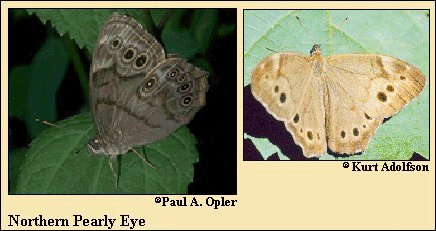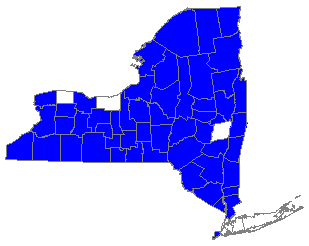 |
 

 |



Northern Pearly Eye (Enodia anthedon Clark)
Wing span: 1 3/4 - 2 5/8 inches (4.5 - 6.7 cm).
Identification: Antennal clubs are black. Upperside is brown with dark eyespots. Underside is brown; submarginal row of 4 black spots on forewing is straight and the dark line inside it is sinuous. Spots are not surrounded by diffuse white.
Life history: Males perch on tree trunks or vegetation up to 10 feet above ground at edges of clearings to wait for females. Eggs are laid singly on the host plant; third- and fourth-stage caterpillars hibernate.
Flight: One brood in the north from June-August, two broods in the south from May-September.
Caterpillar hosts: Various grasses including white grass (Leersia virginica), bearded shorthusk (Brachyelytrum erectum), plumegrass (Erianthus), broadleaf uniola (Uniola latifolia), and bottlebrush (Hystrix patula).
Adult food: Dung, fungi, carrion, and sap from willows, poplars, and birch.
Habitat: Damp deciduous woods, usually near marshes or waterways; mixed or grassy woodlands.
Range: Central Saskatchewan and eastern Nebraska east to Nova Scotia, south to central Alabama and Mississippi.
Conservation: Not usually of conservation concern.
The Nature Conservancy Global Rank: G5 - Demonstrably secure globally, though it may be quite rare in parts of its range, especially at the periphery.
Management needs: None reported.
References:
Opler, P. A. and G. O. Krizek. 1984. Butterflies east of the Great Plains. Johns
Hopkins University Press, Baltimore. 294 pages, 54 color plates.
Opler, P. A. and V. Malikul. 1992. A field guide to eastern butterflies. Peterson
field guide #4. Houghton-Mifflin Co., Boston. 396 pages, 48 color plates.
Scott, J. A. 1986. The butterflies of North America. Stanford University Press,
Stanford, Calif. 583 pages, 64 color plates.
Tilden, J. W. 1986. A field guide to western butterflies. Houghton-Mifflin Co.,
Boston, Mass. 370 pages, 23 color plates.
Author: Jane M. Struttmann
State and Regional References:
Cech, R. 1993. A Distributional Checklist of the Butterflies and Skippers of
the New York City Area (50-mile Radius) and Long Island. New York City
Butterfly Club Special Publication. 27 pp.
Forbes, W.T.M. 1960. Lepidoptera of New York and Neighboring States. Part
IV: Agaristidae through Nymphalidae Including Butterflies. Cornell Univ.
Agricultural Experimental Station, Ithaca, N.Y. Memoir 371. 188 pp.
Glassberg, J. 1993. Butterflies Through Binoculars: A Field Guide to
Butterflies in the Boston-New York-Washington Region. Oxford Univ. Press,
New York, N.Y. 160 pp.
Klass, C. and Dirig, R. 1992. Learning about Butterflies. Cornell Cooperative
Extension Publication, 4-H Member/Leader Guide 139-M-9. Ithaca, N.Y.
36 pp.
Layberry, R.A., Hall, P.W. & Lafontaine, D.J., 1998. The Butterflies of
Canada. University of Toronto Press, Toronto, ON. 280 pp.
Opler, P.A. 1998. A field guide to eastern butterflies, revised format.
Houghton Mifflin Co., Boston.
Shapiro, A.M. 1974. Butterflies and Skippers of New York State. Cornell Univ.
Agricultural Experimental Station, Ithaca, N.Y. Search 4:1-60.

